Chakmas, The
Chakmas, The the largest ethnic tribe in Bangladesh. They also call themselves Changmas. They are concentrated in the central and northern parts of the chittagong hill tracts where they live amidst several other ethnic tribes. Exact population figures are lacking but the most reliable estimates put their number at 140,000 in 1956 and 230,000 in 1981. According to the 1991 population census, there were about 253,000 Chakmas. Over 90 percent of them are concentrated in rangamati and khagrachhari districts. About 100,000 Chakmas also live in India, particularly in the states of Arunachal, Mizoram and Tripura. Small groups have settled in other countries as well.
In 1550 AD the Portuguese mapmaker Lavanha mentioned the settlement of the Chakmas in the Chittagong Hill Tracts. On the earliest surviving map of Bengal he marked that Chakmas lived in a settlement on the karnafuli river.
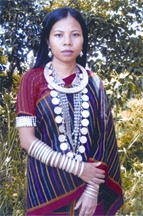
Scholars have put forward two schools of opinion regarding early history of Chakmas. Both assume that they migrated from outside to their present homeland. The most convincing opinion links Chakmas with central Myanmar and arakan, and with groups such as the Sak (chak, Thek) who live in the Chittagong Hill Tracts and Arakan. The other opinion, which lacs historical evidence, assumes that Chakmas migrated to the Chittagong hills from Champaknagar in northern India. In the late eighteenth century, Chakmas were found not only in the Chittagong Hill Tracts but also in other hilly areas of the present-day districts of chittagong and cox’s bazar.
When the government imposed a ban on jhum cultivation in low-lying areas of the Hill Tracts in 1860, many of these Chakma cultivators (and other hill cultivators such as the marma) moved towards eastern region. In the pre-colonial period, the Chittagong Hill Tracts had not been part of any state, although they had long been influenced by the Tripura Raj (to the north), Arakan (to the south) and Bengal (to the west). In the seventeenth and eighteenth centuries, the Mughal Empire collected tribute from the area through local intermediaries. One of the most prominent of these intermediaries was the Chakma chief residing in an elevated landmass in the Karnafuli river channel. His family had considerable landholdings in the plains of Chittagong, ie, inside Mughal territory, and resided in rangunia.
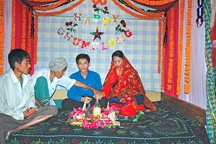
The Chakmas were friendly to the Mughal government because besides paying some revenue in cotton no other demand was made on them and they were allowed to live according to their own ways of life entirely uninterferred. In 1733 the Chakma Chief Shermast Khan had obtained a zamindari sanad for Chakla Rangunia, a hilly tract but cultivable, and it was in the capacity of being a zamindar that the Chakma Chief came under the direct control of the government. Reversing the old policy of non-interfernece, the colonial government tried in the 1770s and 1780s to bring the Chakmas under the direct control of the colonial government.
They were asked to pay revenue in cash rather than in cotton. The rent-rate in the Rangunia zamindari was enhanced. When the Chakma Raja Juan Buksh refused to pay the enhanced rent the Rangunia estate was farmed out to a banian from Kolkata. Rent-free lands of the raja were resumed. All these measures had alienated the hill people so much that in 1776 they revolted against the British control and asserted their independence under the leadership of Ranu Khan, the diwan of the Raja. Ranu Khan followed guerrilla tactics to oust the company from the Hill Tracts. Hit-and-run was their war strategy. Ranu Khan was the supreme military leader. Under him were several commanders under whose were the soldiers called palwans who were mostly recruited from the Kukis. The official records indicate that Juan Baksh and Ranu had made the whole of the Hill Tracts independent of British rule and they were, in addition, trying to extend their control to all of Rangunia and other adjoining tracts of the plains. They tried to regain control on Rangunia zone, which formed their former zamindari. From 1777 to 1781, three full-scale military expeditions were sent against the resistant forces under the command of European officers, but all attempts to subdue them failed. Reporting unsuccessful operations against the resisting Chakmas the Chittagong authority wrote to Governor General Warren Hastings:
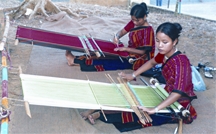
‘...as the Man Ran (Ranu Khan) had been all along looked on as one of no rank, or consideration, I was flattered with the hopes of securing his person, and thereby at once putting on end to his evil designs and practices but this scheme proved abortive.
The man fled from his usual place of residence, and the sepoys 50 in number were sent against him met with resistance, pursued the enemy, and took over and burnt two or three Hillocks and villages where they made head; this was not sufficient to intimidate him; he has assembled men in yet larger bodies, who though' ill armed, harassed the few sepoys on the expeditions, on which Captain Ellerker the Commanding officer judged proper yesterday to send reinforcements making in all 115 sepoys, the number now employed, who are opposed by large bodies of Cookee men, who have been called in by Runoo Cawn, and who live far interior parts of the hills, who have not the use of fire arms, and whose bodies go unclothed.
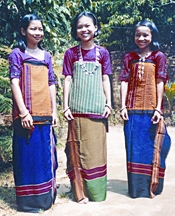
Like Sylhet attempts were made to break Chakma resistance by driving the hill people away from their control in the plain-land parganas first, and then negotiate for a lasting settlement. But while the Chakma leader had showed unwillingness to come to terms with the Company, a harsher and inhuman method was adopted. It was to stop all supplies like dry fish, salt, earthenwares, ironwares, and groceries, spices for which the hill people entirely depended on the plain-land parganas. The blockade could not be much successful because the Chakma forces could open alternative supply lines possible from other trade-routes.
Again, the Chittagong authority then tried to create dissensions among the resistance leadership and side with one party to defeat another. Through secret agents an impression was created in minds of the Chakma chief Juan Baksh that consequent upon the war Ranu Khan was becoming stronger and stronger and soon he would be ambitious enough to oust the Raja. The strategy worked. Keeping Ranu Khan in the dark, Juan Baksh had opened a secret dialogue with the government, which culminated in a formal invitation of the Governor General to Juan Baksh to come to Kolkata and settle the dispute politically.
Juan Baksh went to Kolkata in February 1789 and signed an agreement with the government to the effect that the Company's government would recognise him as the bonafide chief of the Hill tracts where he would rule autonomously. It was also agreed that Juan Baksh would be re-instated in his zamindari of pargana Rangunia and as a zamindar of the Company's state he, like all other zamindars, would be subject to the normal law of the country. Ranu Khan, so long the supreme military leader of the resistance movement, but now forsaken by the Raja, went into wilderness and was never heard of again.
When the British took control of the plains in the mid-eighteenth century, they continued the arrangement, and when they annexed the Chittagong hills a century later, they made the Chakma chief responsible for tax collection in the central region of the new possession. Two other chiefs were made responsible for the southern part (the Bohmong chief) and the northern part (the Mong chief). The Chakma chief, now a colonial grandee endowed with the personal title of raja and some of the trappings of indirect rule, moved to Rangamati, the headquarters of the new district which the British named Chittagong Hill Tracts. The colonial tax system also gave new powers to old functionaries at the local level (talukdar, dewan, khisa) which came to form the Chakma gentry. The Chittagong Hill Tracts Regulation of 1900 formalised this system and also stressed the fact that the area, though administered from calcutta, was not a regular part of Bengal.

Its administrative system, land rights, and closure to outside settlers all set it apart from the rest of Bengal. This status was reconfirmed in the 1930s, when the region was declared an excluded area under the Government of India Act. After decolonisation (1947), the Chittagong Hill Tracts were incorporated into East Pakistan and later (1971) Bangladesh. The special administrative status of the Chittagong Hill Tracts was continued, and the Regulation of 1900 was never clearly rescinded, despite piecemeal mutations. For this reason, the office of the Chakma (and Bohmong and Mong) chief survives till today.
In 1906, a hydroelectric project was proposed to be built, using the flow of the water in the Karnafuli river. But it was not until the 1950s that the plan took shape and a large hydroelectric project was commissioned at kaptai, a riverside village close to Rangamati. When the Kaptai dam was completed in 1960, a big lake formed in the Karnafuli valley, flooding many villages and leading to the great exodus (or Bara Parang, as the Chakmas call it). About 100,000 people are thought to have fled the waters, most of them Chakmas. Many settled elsewhere in the district, including reserved forest areas, but in 1964, tens of thousands sought refuge in India.
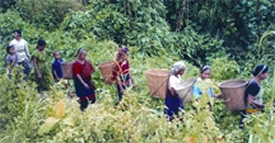
The smoldering grievances eventually led to an armed conflict between the PCJSS (Parbatya Chattagram Jana Sanghati Samiti, or United People’s Party of the Chittagong Hill Tracts) founded in 1972, and the Bangladesh armed forces. The PCJSS, led mainly by Chakmas, signed a peace agreement with the Bangladesh government in 1997.
Traditionally, the Chakma lifestyle was closely linked with hill agriculture or shifting cultivation (jum in Chakma and jhum in Bengali). Living in settled villages, they would cultivate plots on surrounding hills for some years, then leave them fallow to recuperate naturally. Chakmas also cultivated land in river valleys. They had a well-developed system of land rights, which differed sharply from those in the plains (see land tenure).
According to early observers, the living standard of cultivators in the Chittagong hills was relatively high. rice, cotton and vegetables were important crops. The bamboo was essential as building material. The bamboo had so many other uses that the Chakma lifestyle has been described as a 'bamboo civilisation'. In the colonial period, social differentiation grew as an elite developed, basing its lifestyle on a share of the government tax and on educational achievements. In the twentieth century, population growth made hill cultivation more problematic mainly because fallow periods had to be shortened - and more Chakmas had to find non-agricultural jobs.
Their problem was intensified by the government policy of transmigration. From the late 1970s, hundreds of thousands of poor Bengali lowland cultivators came to settle in the Chittagong hills under military protection. Land scarcity increased sharply, and Chakmas (and other hill people) saw their lifestyle threatened further. Many were forced into low-income wage labour (e.g. on new rubber plantations); over 50,000 fled their country and lived on doles in refugee camps in Tripura (India) from 1986 till their repatriation in 1998.
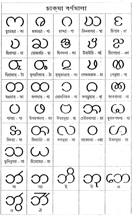
Chakmas distinguish themselves from surrounding groups by their language. Although there are indications that Chakmas used to speak a Tibeto-Burman language, their present language is Indo-European. It is closely related in structure to Chittagonian Bengali from which it differs by a distinct vocabulary. Most Chakmas are bilingual and speak Chakma and Bengali; many know other regional languages as well. The Chakma language has its own script, although today this is not commonly used and Chakma is now usually written in Bengali letters. Chakma literature runs from the oral traditions of the gengkhuli singers through literary periodicals (the first of which was Goirika started in 1936) to modern poetry. Another modern art form in which Chakmas made their mark is painting.
The vast majority of Chakmas are Buddhists, and they form the largest Buddhist population in Bangladesh. Integrated in their Buddhist practice are older religious elements, such as worship of the powers of nature. One of their annual highlights is the Bizu festival held in Chaitra, the last month of the Bengali year. Culturally, the Chakmas are in many ways more Southeast Asian than South Asian. They know neither the dietary restrictions nor the strict gender segregation of their Bengali neighbours. [Willem Van Schendel]
Bibliography Willem van Schendel (ed), Francis Buchanan in South-east Bengal (1798): His Journey to Chittagong, Chittagong Hill Tracts, Noakhali and Comilla; Meshbah Kamal et al, Cultural Survey of Bangladesh Series-5, Indigenous Communities, Asiatic Society of Bangladesh 2007; Sirajul Islam (ed), History of Bangladesh, vol. 1 (2007), chapter Five
